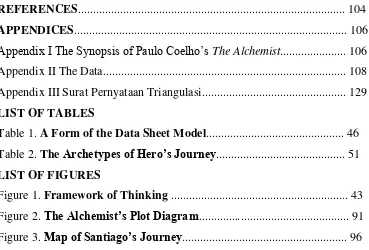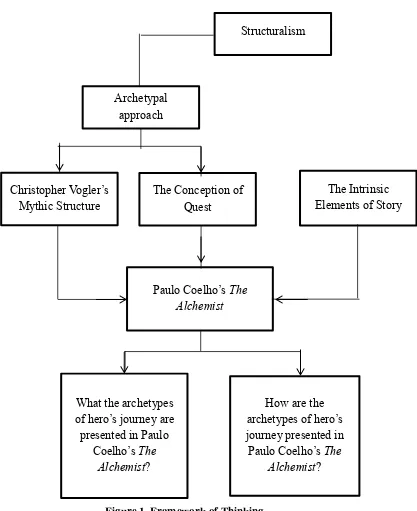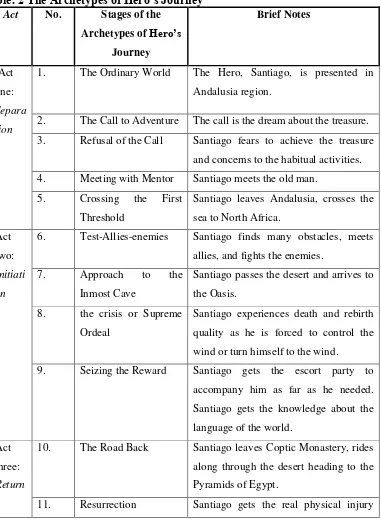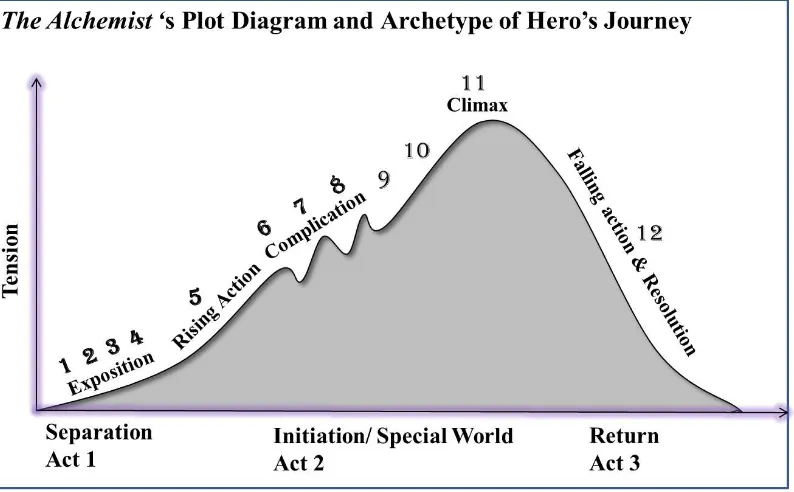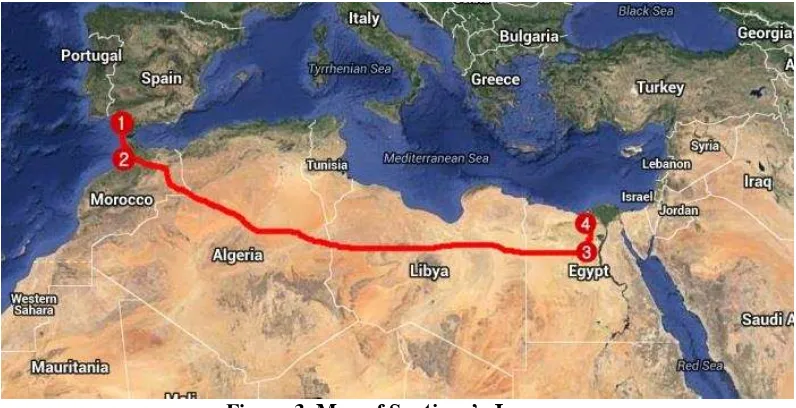Informasi Dokumen
- Penulis:
- Sri Wahyuni
- Sekolah: Yogyakarta State University
- Mata Pelajaran: English Literature Study Program
- Topik: The Archetypes of Hero’s Journey in Paulo Coelho’s The Alchemist
- Tipe: thesis
- Tahun: 2016
- Kota: Yogyakarta
Ringkasan Dokumen
I. INTRODUCTION
The introduction sets the stage for the exploration of archetypes within Paulo Coelho's 'The Alchemist'. It discusses the significance of literature in understanding human experiences and emphasizes the role of the hero's journey in narrative fiction. The quest narrative is a prominent theme, illustrating how characters evolve through trials and experiences. This section underscores the educational value of analyzing literary archetypes, as it fosters critical thinking and personal growth among students. By engaging with the text, learners can relate the hero's journey to their own life experiences, enhancing their understanding of literature and its impact on human psychology.
1.1 Background of the Study
This subsection elaborates on the importance of literature as a reflection of human experience and societal values. It discusses how literature, particularly narrative fiction, serves as a vehicle for personal and intellectual growth. The background emphasizes the relevance of the hero's journey, as it mirrors the universal human experience of growth and transformation, thus providing a framework for students to analyze their own journeys and the narratives they encounter.
1.2 Research Focus
The research focus narrows down to the archetypal structures present in 'The Alchemist'. It highlights the necessity of understanding these archetypes to grasp the broader implications of the hero's journey in literature. This focus is crucial for students as it encourages them to identify recurring themes and patterns in various narratives, enhancing their analytical skills and fostering a deeper appreciation for literary works.
1.3 Research Objectives
The objectives outline the aims of the research, which include describing the archetypes of the hero's journey and analyzing their presentation in 'The Alchemist'. This clarity of purpose serves as a guide for students, helping them to engage with the text critically and understand the significance of archetypal analysis in literature.
1.4 Research Significance
This subsection discusses the theoretical and practical significance of the research. It emphasizes how the findings can enrich literary studies, particularly in archetypal criticism. For students, understanding the significance of these archetypes can deepen their comprehension of narrative structures and enhance their critical reading skills, ultimately encouraging further exploration of literary themes and archetypes.
II. LITERATURE REVIEW
The literature review provides a comprehensive overview of the theoretical frameworks relevant to the study, including structuralism, archetypes, and myth studies. It emphasizes the interconnectedness of these concepts and their application in analyzing literature. This section is vital for students as it equips them with the necessary theoretical background to engage with the text meaningfully. By understanding these frameworks, learners can apply critical theories to their analyses, fostering a more profound understanding of narrative techniques and themes.
2.1 Theoretical Description
This subsection delves into the key theories that underpin the analysis of archetypes in literature. It discusses structuralism and its focus on narrative structures, as well as the significance of archetypes in understanding universal themes across cultures. This theoretical grounding is essential for students, as it provides them with a lens through which to view and interpret literary texts, enhancing their analytical capabilities.
2.2 Review of Previous Related Research Findings
In this section, previous research related to archetypes and hero's journey is reviewed, highlighting the contributions of various scholars. This review is crucial for students as it situates their research within the existing body of literature, allowing them to identify gaps and opportunities for further exploration. Understanding previous findings can also inspire students to develop their unique perspectives on archetypal analysis.
2.3 Paulo Coelho and The Alchemist
This subsection examines Coelho's background and the thematic elements of 'The Alchemist'. It provides context for understanding the narrative's archetypal structures. For students, this contextual knowledge is important as it enriches their reading experience and helps them appreciate the author's intent and the cultural significance of the text.
2.4 Conceptual Framework
The conceptual framework outlines the methodological approach taken in the research. It serves as a roadmap for students, guiding them through the analytical process. By understanding the framework, learners can better navigate their analyses and apply the discussed theories to their interpretations of the text.
III. RESEARCH METHOD
This section details the research design and methodology employed in the study. It emphasizes the qualitative approach and the techniques used for data collection and analysis. Understanding these methods is crucial for students, as it equips them with the tools necessary for conducting their research and applying similar methodologies in their academic pursuits.
3.1 The Research Design
This subsection outlines the overall design of the research, focusing on the qualitative approach. It explains how this design is suitable for exploring the archetypes in 'The Alchemist'. For students, grasping the research design helps them understand how to structure their inquiries and the importance of aligning methodologies with research objectives.
3.2 Data Type
Here, the types of data collected for the analysis are specified. This section is important for students as it illustrates the significance of selecting appropriate data types for research, impacting the overall findings and conclusions.
3.3 Data Source
This subsection identifies the sources from which data was gathered. Understanding data sources is crucial for students, as it emphasizes the importance of credible and relevant information in research.
3.4 Data Collecting Technique
The techniques used for collecting data are discussed in this section. For students, learning about data collection methods enhances their research skills and prepares them for future academic projects.
3.5 Data Analysis
This subsection details the process of analyzing the collected data. It is essential for students as it provides insight into how to interpret findings and draw conclusions based on evidence.
3.6 Validity and Trustworthiness
This section addresses the measures taken to ensure the validity and trustworthiness of the research. Understanding these concepts is crucial for students, as it reinforces the importance of rigor and credibility in academic work.
IV. FINDINGS AND DISCUSSION
The findings and discussion section presents the results of the analysis, focusing on the archetypes of the hero's journey in 'The Alchemist'. It explores how these archetypes manifest through various narrative elements. This section is vital for students, as it connects theoretical concepts to practical examples, enhancing their understanding of literary analysis.
4.1 The Archetypes of Hero’s Journey in The Alchemist
This subsection identifies and describes the specific archetypes present in the novel. For students, recognizing these archetypes is essential for understanding character development and thematic depth in literature.
4.2 Literary Elements that Present the Archetypes
This section discusses the literary elements that contribute to the presentation of archetypes in 'The Alchemist'. Understanding these elements is crucial for students, as it enhances their analytical skills and allows them to appreciate the intricacies of narrative construction.
V. CONCLUSIONS
The conclusion summarizes the key findings of the research and reflects on the significance of archetypal analysis in literature. It emphasizes the educational value of understanding the hero's journey and its relevance to personal growth. For students, this section serves as a reminder of the importance of literary studies in fostering critical thinking and self-reflection.
Referensi Dokumen
- The Alchemist ( Paulo Coelho )
